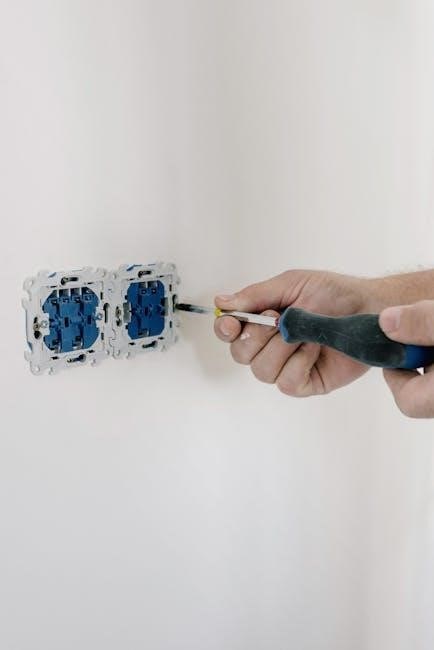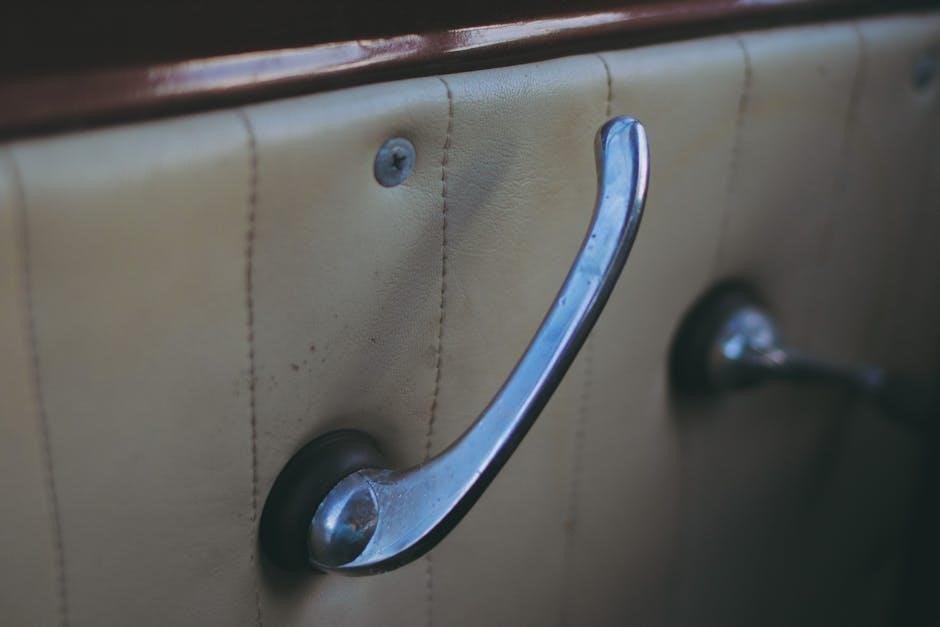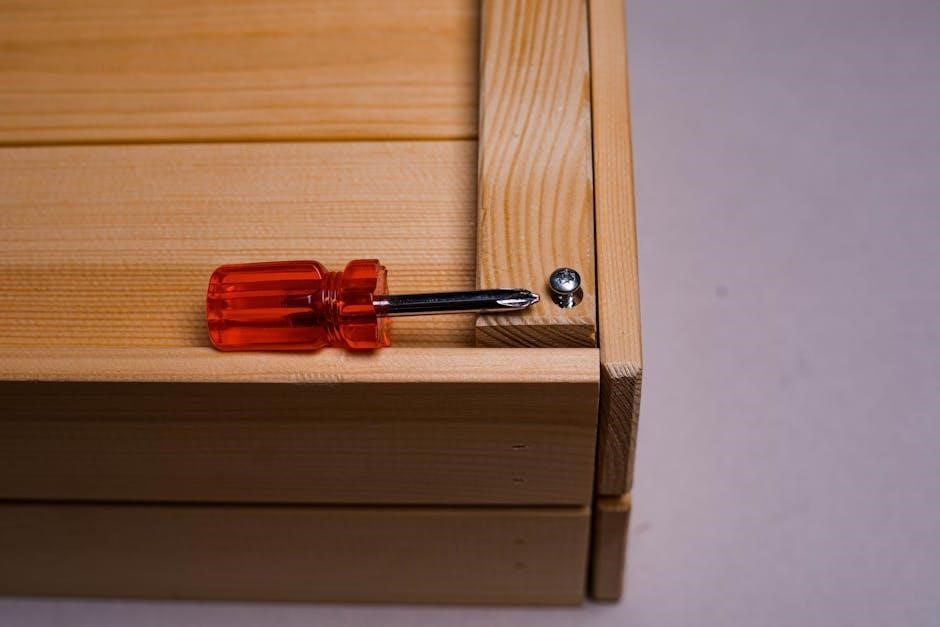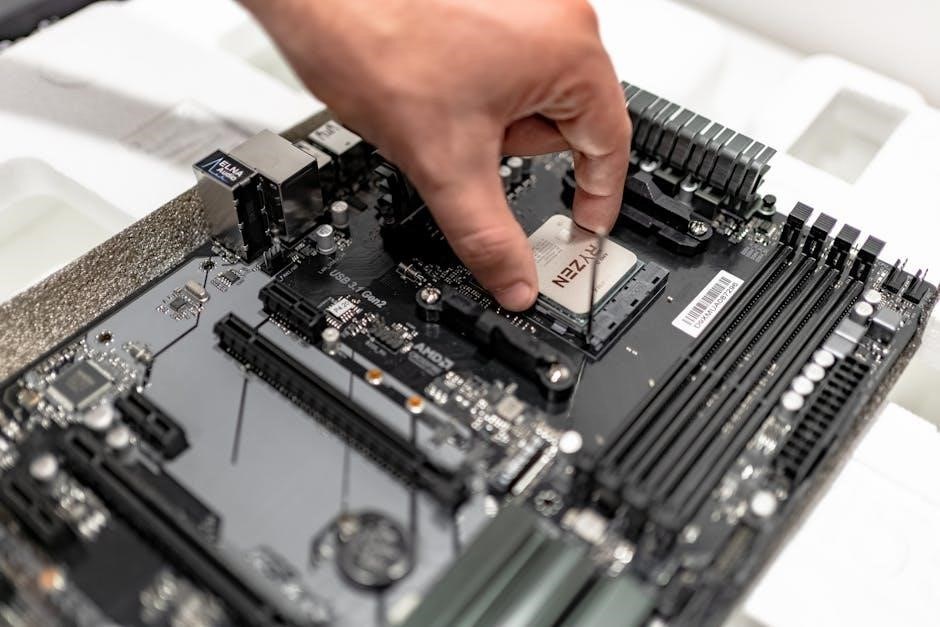
-
By:
- dane
- No comment
door closer installation manual
Pre-Installation Checklist
Verify door closer compatibility with door type, weight, and frame dimensions. Ensure spring power matches door size. Check all hardware and tools are available. Follow manufacturer guidelines for proper installation sequence.
1.1 Essential Tools and Materials

To ensure a smooth installation, gather the following tools and materials: a drill with 7/64″ and 13/64″ bits, 1/4-20 tap, screwdrivers (Phillips and flathead), measuring tape, pencil, and a level. For materials, you’ll need 1/4-20 machine screws, wood screws, and spacer shims. Depending on the door type, additional hardware like swing clear hinges or reinforced door frames may be required. Always refer to the manufacturer’s manual for specific hardware needs, as some closer models may require unique components. Ensure all tools are in good condition and readily available to avoid delays. Proper preparation of these items will streamline the installation process and ensure accuracy. Double-check the door closer kit for any pre-included hardware to avoid duplication.
1.2 Understanding Door and Frame Requirements
Ensure the door and frame meet the closer’s specifications, including weight, size, and material. Doors must be properly reinforced, especially for heavy or large applications. Standard door clearances (1/8″) and stop heights (5/8″) are critical for proper functionality. Verify hinge placement and alignment with the frame. For exterior doors, ensure the closer is not installed on the weather side. Check if the door is left- or right-handed, as this affects installation symmetry. Use swing clear hinges if required for wider openings. Ensure the frame is sturdy and compatible with the closer’s mounting hardware. Always follow manufacturer guidelines for specific door and frame requirements to ensure safe and reliable operation. Proper door and frame preparation is essential for optimal performance and longevity of the closer.

Mounting the Door Closer
Mark the door for closer installation based on manufacturer templates. Drill pilot holes and secure the closer using provided screws. Ensure proper alignment with door hinges.
2.1 Positioning the Closer on the Door
Position the door closer on the door, aligning it with the hinge edge. Ensure the spring power adjustment is accessible. Mark the screw locations using the template provided. Verify alignment with the door frame to ensure proper functionality. Double-check the manufacturer’s specifications for left or right-handed doors. Proper positioning ensures smooth operation and prevents damage to the door or frame. Always refer to the installation manual for specific guidance tailored to your door closer model.
2.2 Drilling Pilot Holes and Securing the Closer
Using the marked locations from the template, drill pilot holes into the door using a 1/8″ or 13/64″ drill bit. Ensure the holes are aligned and straight to avoid misalignment. Insert the provided screws into the pilot holes and gently tighten them to secure the closer to the door. Do not overtighten, as this may damage the door or closer. Verify that the closer is evenly positioned and aligned with the door frame. Double-check the manufacturer’s instructions for specific torque requirements. Properly securing the closer ensures stability and optimal performance of the door closing mechanism. Always refer to the manual for model-specific guidelines to avoid installation errors.

Installing the Arm and Shoe Assembly

Attach the forearm to the main arm using the provided screws. Secure the shoe assembly to the door frame, ensuring proper alignment with the closer.
3.1 Attaching the Forearm to the Main Arm
Begin by removing any protective covering from the forearm and main arm. Align the forearm with the main arm, ensuring proper fitment. Use the provided screws to secure the forearm to the main arm tightly. Verify alignment with the door frame and adjust the forearm length if necessary. Ensure the connection is secure to prevent loosening during operation.
3.2 Securing the Arm Shoe to the Frame
Position the arm shoe on the door frame, ensuring proper alignment with the forearm. Mark the frame where the shoe will be mounted, using the provided template or measurements. Drill pilot holes at the marked locations, ensuring they are straight and accurately placed. Secure the arm shoe to the frame using the screws provided in the hardware kit. Tighten the screws firmly to prevent any movement or loosening over time. Double-check the alignment between the arm shoe and the forearm to ensure smooth operation. If necessary, adjust the shoe’s position slightly for optimal performance. Finally, test the door’s movement to confirm the arm shoe is securely fastened and functioning correctly.

Adjusting the Door Closer

Adjust spring power by turning the adjustment screw counterclockwise (C.C.W) to increase or clockwise (C.W.) to decrease. Fine-tune closing and latching speeds for smooth operation.
4.1 Spring Power Adjustment
Locate the spring power adjustment screw on the door closer body, typically marked or positioned near the main spring. To increase spring tension, turn the screw counterclockwise (C.C.W). To decrease tension, turn it clockwise (C.W.). Start with small adjustments, then test the door’s closing force. Ensure the door closes smoothly without slamming or struggling to latch. Refer to the manufacturer’s guidelines for specific torque settings or visual indicators. Proper spring power ensures the door closes efficiently and safely, balancing user comfort with functional reliability. Always test adjustments by opening the door to various angles and observing its closing behavior.
4.2 Closing and Latching Speed Controls
Locate the closing and latching speed control valves, typically marked on the door closer body. To adjust the closing speed, turn the valve clockwise (C.W.) to slow down or counterclockwise (C.C.W.) to speed up. For latching speed, a separate valve controls the final closing motion to ensure the door latches securely. Make small adjustments and test the door’s operation after each change. Proper adjustment ensures smooth, quiet operation and prevents slamming or failure to latch. Start with factory-recommended settings and fine-tune as needed. Regularly inspect and maintain these controls to ensure consistent performance and safety. Refer to the manufacturer’s instructions for specific guidelines on adjustment sequences and torque limits.

Final Checks and Maintenance
Test door operation to ensure smooth closing and latching. Check all adjustments for proper function. Lubricate moving parts annually. Inspect and maintain components regularly for optimal performance.
5.1 Testing the Door Operation
After installation, test the door to ensure smooth operation. Check that the door closes fully and latches properly. Verify closing speed and backcheck functionality. Ensure the door aligns correctly with the frame. Test under various conditions to confirm consistent performance. Adjust spring power or speed controls if necessary. Inspect for proper arm alignment and shoe clearance. Ensure no binding or resistance during operation. Test door operation repeatedly to confirm reliability. Refer to the manual for troubleshooting common issues. Ensure all adjustments meet safety and functionality standards.
5.2 Regular Maintenance Tips
Regularly inspect the door closer for proper function and wear. Lubricate moving parts to ensure smooth operation. Check spring tension and speed controls for optimal performance; Tighten all screws and fasteners to prevent loosening. Inspect the arm shoe and hinge for alignment and damage. Clean debris from the closer body and shoe. Replace worn-out components promptly. Test door operation periodically to maintain reliability. Adjust spring power or speed controls as needed. Ensure proper door alignment with the frame. Schedule professional maintenance for complex adjustments. Keep the closer free from dust and moisture. Refer to the manual for specific maintenance recommendations. Regular upkeep ensures long-term functionality and safety.